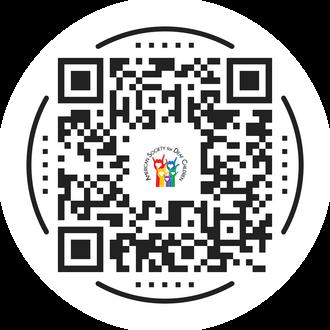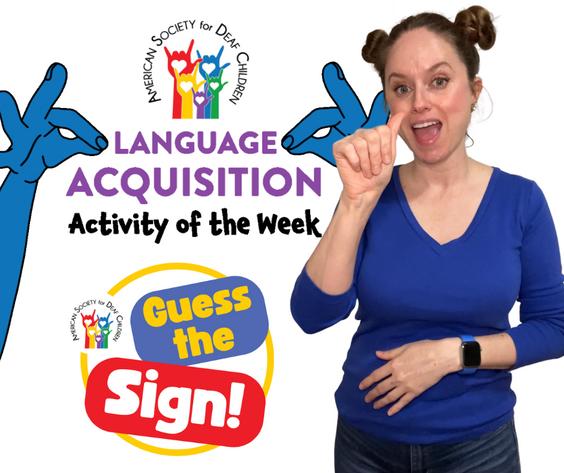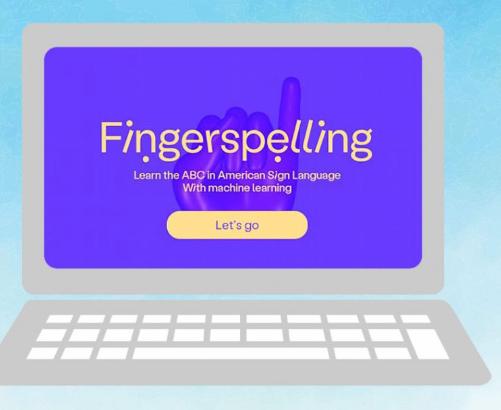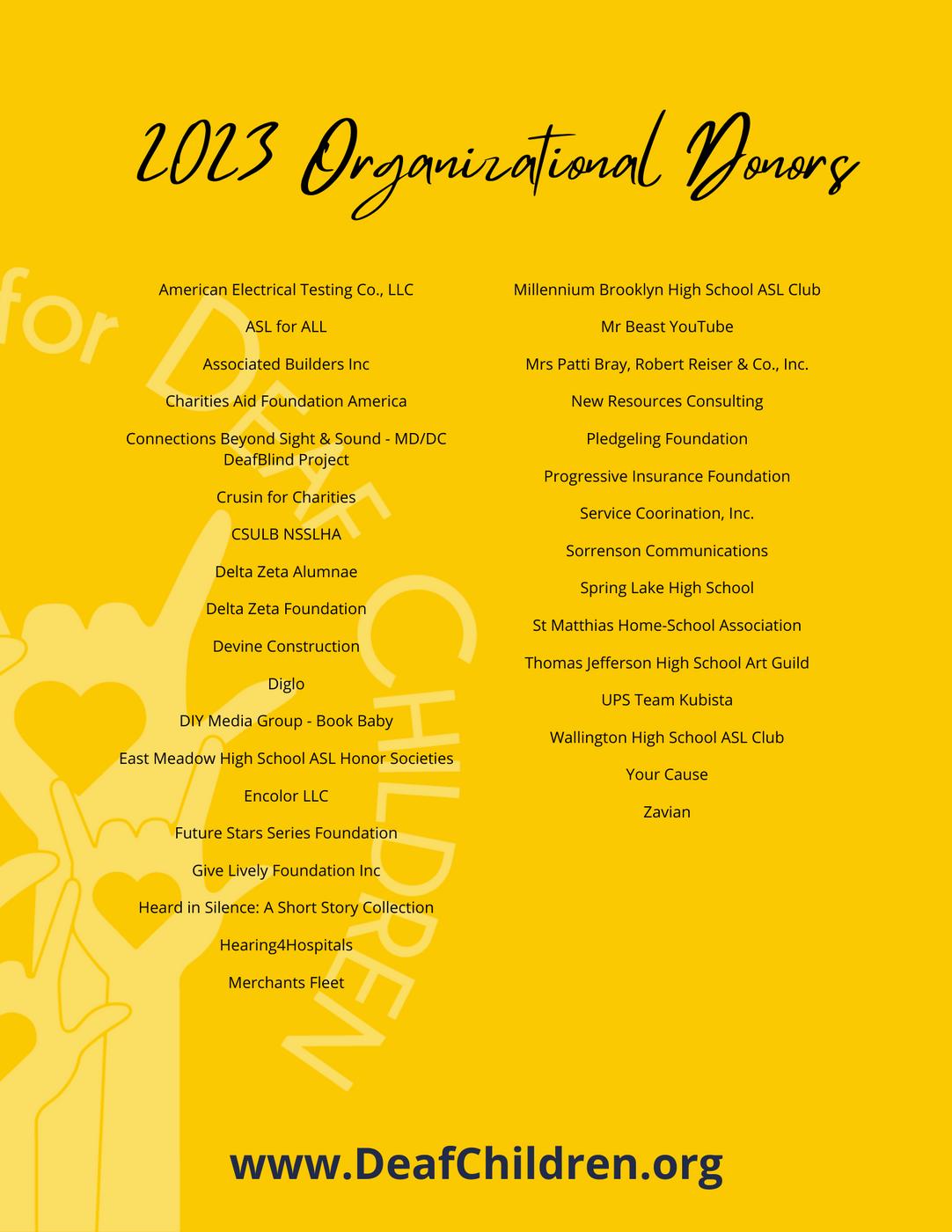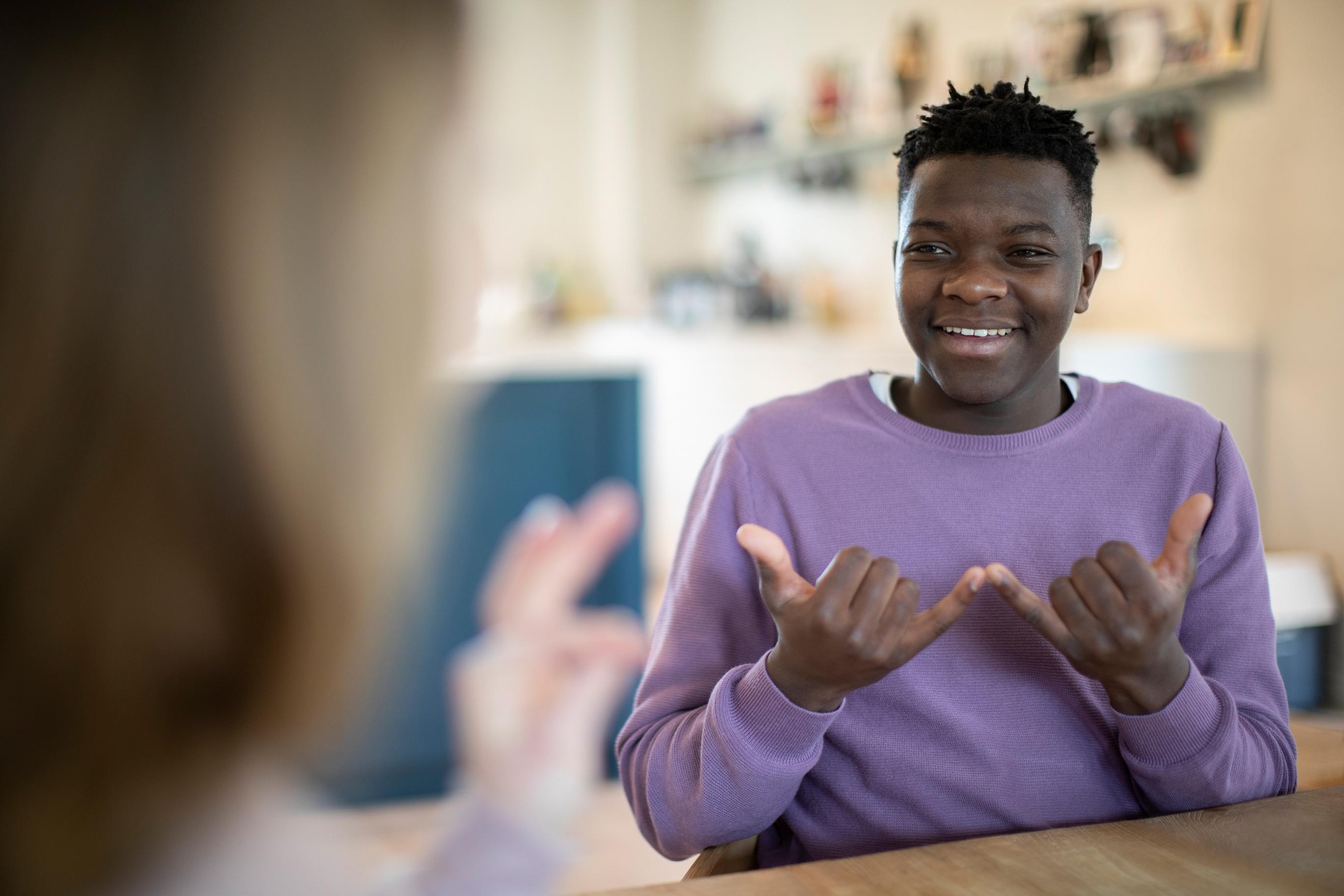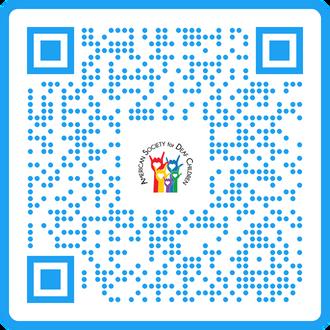ENDEAVORThe


EVERY CHILD, EVERY VOICE, EVERY BATTLE FOR EQUITY
UNA GUÍA PARA PADRES Y FAMILIAS DE NIÑOS SORDOS



Learn ASL




EVERY CHILD, EVERY VOICE, EVERY BATTLE FOR EQUITY
UNA GUÍA PARA PADRES Y FAMILIAS DE NIÑOS SORDOS




Learn ASL or take your signing skills to the next level with our monthly classes, workshops, and webinars.
Get instant access to hundreds of videos featureing ASL retellings of children’s books and ASL language development for all ages.
Resources for Latino Families
Virtual ASL classes, workshops, and groups especially for Latino families with Deaf or Hardof-Hearing children Find support in learning ASL, working with schools, empowering the family, addressing mental health wellness, and many other topics. All courses held in Spanish.
Fully immersive, interpreter-supported events designed especially for families with and professionals who work with Deaf, Hard-ofHearing, and DeafBlind children.
Learn More About ASDC at

Language allows us to learn, build relationships, and succeed.
To create connections.
Our aim is to keep children tied to the lifelong learning path, no matter what, till they reach their educational objectives, and beyond.
We believe Deaf/Hard-ofHearing children & youth are entitled to full communication access and that those communication opportunities for Deaf children should be based on facts and needs.
It starts from day one.
It takes collaborative, informed, and committed teamwork to create successful learning experiences for our children that ensure that all plans and programs meet the needs of each one of them, individually and uniquely
At ASDC, we are committed to leading the way to creating accessible language for all.
Join us.
In the world of education, literacy and language development stand as pillars of empowerment, particularly for deaf and hard-of-hearing children.
Through the perspective of Amplifying Access, a social call to action dedicated to enhancing accessibility and inclusivity, the significance of nurturing linguistic abilities in these children becomes even more pronounced
For deaf and hard-of-hearing children, language proficiency is not merely a skill but a pathway to communication, knowledge acquisition, and social integration.
Amplifying Access emphasizes the importance of providing these children with the necessary resources and support to develop their literacy skills and language competencies.
By embracing linguistic diversity and accommodating different communication modalities, Amplifying Access fosters inclusive environments where deaf and hard-of-hearing individuals are valued members of society. This approach promotes empathy, understanding, and acceptance, ensuring that every child has the opportunity to thrive regardless of their hearing status

The empowerment of deaf and hard-ofhearing children through literacy and language development becomes not only a matter of education but also a testament to the values of accessibility, inclusivity, and social equity. 4

 By Cheri Dowling, Executive Director
Amy T Andersen, MS, NBCT, ASLTA-
By Cheri Dowling, Executive Director
Amy T Andersen, MS, NBCT, ASLTA-

EDITOR-IN-CHIEF
Cheri Dowling
MANAGING EDITOR
Wendy Kelly
ART DIRECTION
Indigo Blue Consulting
CONTRIBUTING WRITERS
Amy T. Hansen
Wendy Kelly
Patti Sanchez
Samantha Singletary
Rachel Zemach

Welcome to the Spring 2024 Edition of The Endeavor!
We're excited to present another captivating installment of ASDC's esteemed publication, The Endeavor This edition upholds our commitment to providing valuable literary resources for parents, educators, professionals, and advocates alike.
Under the theme "Amplifying Access," this edition echoes the core values of inclusivity and empowerment that drive our work at ASDC. Within these pages, you'll find thought-provoking articles and stories, including our first Spanish-language article, that delve into the heart of deaf education, each brimming with knowledge and inspiration!
As we embrace the vibrant energy of spring, let's seize the opportunity to advance inclusive education Throughout this edition, you'll encounter insights and perspectives aimed at enhancing access to education and language for all
Accessing The Endeavor has never been simpler. Visit www.deafchildren.org to explore our publication, and don't forget to sign up for our email updates on our website to stay connected with our dynamic community.
We extend our heartfelt gratitude to those who support the vital work of the American Society for Deaf Children and our allied partners Your contributions fuel our mission and propel us toward a more inclusive world
The Spring 2024 Edition of The Endeavor stands as a testament to the power of collaboration and the boundless potential of access Join us as we amplify access and advocate for change
Warm regard

Thoughts from ASDC’s Executive Director, Cheri Dowling

"Welcome to the Spring 2024 edition of The Endeavor! This time, we're focusing on a topic close to my heart: Amplifying Access. Language plays a crucial role in ensuring respect and opportunities for all individuals to flourish
At ASDC, we firmly believe that language access, including sign language, should be a fundamental right Language is not just a tool for communication; it's the foundation of sharing ideas, celebrating diverse cultures, and expressing identities Denying access to literacy and language silences voices and contradicts our core values
In our mission to create supportive and accessible environments, engaging individuals, families, and communities is paramount A holistic approach ensures that every member feels valued and empowered, fostering growth and understanding Together, we can nurture belonging and resilience within our families and communities
American Sign Language (ASL) is not only essential for the deaf and hardof-hearing community but for society as a whole ASL serves as a bridge, fostering understanding and connection beyond linguistic and cultural barriers ASDC advocates for language access from infancy, recognizing its transformative impact on cognitive and linguistic development
Ensuring equitable access to education and fostering inclusivity require proactive steps Advocating for sign language interpreters, providing educational resources in ASL, and integrating ASL and deaf culture into curricula are crucial Inclusive policies and practices, coupled with respect for diversity, are key to building a society where everyone can thrive
Creating a world where everyone feels valued and included involves breaking down barriers to equity and accessibility Amplifying Access is the key to achieving this goal Let's work together to build a languagerich society where every individual has the opportunity to shine
Thank you for joining us on this journey Happy reading!

Cheri Dowling, Executive Director American Society for Deaf Children

Executive Committee
Judie Lomax Board President
Jennifer Luce Vice President
Lauri Rush Treasurer
Carlisa Thompson Secretary
Malibu Barron Past President
Members
Angelica Lee Gagliardi
Patrick Graham
Michelle Jablonka
Brenda Perrodin
Maria Romero
“The limits of my language mean the limits of my world.”
-LUDWIG WITTGENSTEIN.

Learn ASL with ASDC's Online Classes, Workshops, and Webinars
Elevate your ASL skills with our signature
4-week Learn ASL series
Enroll now! Classes fill fast!
$75 per series for ASDC Members
$100 per series for Non-ASDC Members
www.DeafChildren.org
4-WEEK ASL CLASSES OFFERED
Beginning Level One & Two
Intermediate Level One & Two
Advanced
Beginning for Kids 7+
Advanced for Kids 7+
Conversational Skills
Storytelling with ASL and more!


ASDC Members have access to exclusive monthly workshops designed to help them support, advocate for, and empower their D/HH child. Check our website for upcoming workshops* such as:
The Bi-Lingual Approach to Learning Language
Is My Kid Ready for Kindergarten?
Preparing your DHH Child for SelfAdvocacy at School and more!!
CHECK OUT OUR FULL ROSTER OF CLASSES AND WORKSHOPS!

As a teacher of the deaf and teacher of American Sign Language (ASL), advocating for every child's right to their culture and identity has always been as important to me as teaching In 2018, as the NJ State Teacher of the Year, my ability to successfully advocate for deaf children in my state was magnified, and for that, I will always be most proud and grateful
This story begins nine years ago when I met the Renart family: two grieving parents, a 6-year-old big brother, and beautiful baby twin boys, one deaf and one hearing. This family would guide my trajectory to ignite change in a system statewide. This story is about knocking down barriers to guarantee a little boy the educational opportunities he deserves It is about the right that every child has to their voice, spoken or signed, and the human right we all have to communicate This is a story
about the day I saw a deaf baby's eyes genuinely smile for the first time as he connected to the world around him through ASL
When I met Cole's mother, Stephanie, she told me about the day she learned her baby was deaf She was sitting in the doctor's office thinking, "How am I ever going to tell my husband our baby will never hear?" With one deaf and one hearing twin, as the babies grew up, Stephanie and her husband couldn't miss the differences. Ryan was repeating sounds, babbling, and responding to simple directions. Cole was not. He couldn't hear those sounds or simple directions. He was babbling but with his hands. Stephanie's instincts drew her to sign even though the doctors had advised against it Using visual language made sense, and she was committed to giving her baby a voice Through early intervention,
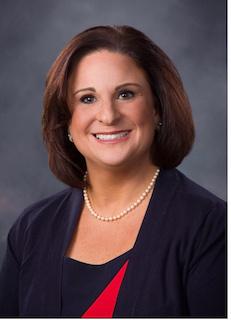
Cole's family met with a teacher of the deaf one day a week for an hour, learning sign language and how to incorporate it into daily routines One hour per week for eight months, and Cole seemed stuck
Early intervention systems are family-centric The service provider goes into the home, works with the parents, and provides activities the parents can work into daily routines within the home This approach assumes that one of the parents is home with the baby.
There are two obstacles this approach can present for deaf babies. First, more than 90% of parents with deaf children are hearing and do not know sign language, let alone have a fluency level in ASL to provide the regular interactive language a child needs to begin acquiring language Second, most families with children have two working parents; in single-parent families, that parent works As a result, children may spend most of their waking hours in a daycare setting, not in the home, with a stay-at-home

who can implement what they learn during early intervention sessions
In a typical daycare environment, the childcare workers interact naturally with the children throughout the day, talking about what a child is playing with, reading stories, and talking about people and things in the environment. Time spent listening to and interacting with language is a crucial component of language development. But for deaf children, daycare is a place without an accessible language This presents a significant barrier for deaf babies to acquire a language foundation Research worldwide shows a systemic increase in the number of deaf children entering kindergarten at a severe disadvantage due to language deprivation
Cole spent 47 hours a week in a daycare with caring teachers interacting with him but in a language he could not hear.
For only one hour a week, Cole had language access when his teacher of the deaf was working with him For the other 46 hours, Cole was isolated from his teachers and peers Cole's mother, Stephanie, knew she needed more, and Cole required more. There needed to be more than one hour a week. So, she found an ASL class at a local community college and enrolled, desperate for a way to reach her deaf baby Stephanie learned more signs every week and continued to meet with Cole's early intervention teacher for the deaf, but Cole still wasn't making progress Then, Stephanie was told that Cole's teacher for the deaf was going on maternity leave, and no other teachers in the area were available to work with Cole. The next day, she went to pick up Cole and Ryan at daycare, and when she walked into the room, Cole was in a corner by himself while the other kids ran around the room laughing For the first time, she realized just how
isolated Cole was, and she felt a sense of hopelessness, unsure of how to open up his world in a place where no one could sign, and Cole couldn't hear the language being used. That night, Stephanie went to her ASL class and sat next to her friend Denise, the mother of one of my ASL students Denise told Stephanie about our monthly ASL chats with the deaf community The next night, at our December ASL Chat, I met Cole and his family for the first time I immediately introduced them to our local deaf community, and Stephanie was able to ask about them growing up deaf in a hearing world. Later that night, I offered to be Cole's teacher of the deaf for his early intervention services. Stephanie cried that night but not out of despair. She finally felt HOPE.
As I started working with Cole, I knew he needed to be in a language-rich

“The possibilities for Cole became limitless because he was given the gifts of love, language, and voice. “
-Amy T Andersen
environment, exposed to an accessible visual language with a native user of ASL For months, I called the early intervention agency I worked for and sent research articles, hoping we could find a way to add visual language to Cole's daycare environment. I shared everything I knew with Stephanie, who, as his parent, also began to advocate. We asked Cole to have a deaf, native user of ASL with him in daycare, signing throughout the day, just like the hearing babies had teachers talking to them throughout the day The agency told us this had never been done before and suggested we teach Cole's daycare teachers sign language At that time, Cole was 18 months old and didn't have time to wait for his teachers to learn some signs Stephanie made calls every day and refused to give up Finally, we sat down for an emergency meeting in January 2017.
Cole's mother and I provided resources showing the importance of language acquisition for deaf children, and most importantly, we spoke from our hearts. We advocated for a deaf ASL user to be placed in Cole's daycare classroom Representatives from the early intervention agency expressed concern that we would never find someone like that, even if they approved the request Fortunately, we had already found a trusted member of
the local deaf community who was anxious to jump in and be the first to pioneer this approach With persistence and determination, we finally convinced the New Jersey Early Intervention system to do something they had never done before. Cole became the first deaf baby in New Jersey and the country to have a deaf para-professional in the daycare setting for twentyfive hours a week. He finally had access to a visual language he could naturally acquire, and his language exploded!
When Cole turned 3, he knew his colors, numbers, and animals and could fingerspell M-A-X, the name of his favorite toy dog Cole could tell his mother he wasn't feeling well or was scared to ride the Ferris wheel at the boardwalk He could tell his mother he was excited that his daddy gave him candy, which sometimes got daddy in trouble. Cole loved school because he knew that his deaf language role model would communicate with him and that he could share with his teachers and friends, who were all starting to learn to sign Soon, many of Cole's friends signed with him and knew how to get his attention by waving to him or tapping him on the shoulder Expressing his wants, needs, likes, and dislikes opened this baby's
world and allowed him to forge relationships with his parents, brothers, and friends
Now, as a thriving, bilingual eight-year-old, Cole's confidence is clear to anyone who meets him He is a leader and academically on par with his peers. He is on his local basketball team and loves playing Roblox, swimming, and FaceTiming with friends. Sometimes, I even get a Marco Polo video from Cole telling me he's dyeing his hair green for St Patrick's Day or showing me a new magic trick he's learned! Cole wants to be a veterinarian when he grows up
This happy ending did not stop with Cole and the Renart family In collaboration with deaf colleagues Michelle Cline and Christopher Sullivan, I submitted a proposal to the NJ Legislature called "Leveling the Playing Field: A Language Acquisition Program for Deaf and Hard of Hearing Children." The proposal was based on the service model we pioneered with Cole and sought to expand it statewide for all deaf, hard-of-hearing, and deafblind babies and their families Sure enough, on a surprising day in July, I received a phone call letting me know the proposal was accepted, and the program would receive $550,000 annually
to provide this service, free of charge, to families throughout New Jersey All of those babies and all of those voices now receive access to language in their n their daycare environments!
The possibilities for Cole became limitless because he was given the gifts of love, language, and voice. Cole's story shows how one child's story can affect many and how education and language access are liberating. It's a story about parents who refused to take " no " for an answer and about the love and determination of a teacher and community fighting to empower a little boy to succeed, not as a version of everyone else, but as himself Cole taught us all that with dedication and hope, we can break down barriers to ensure every child receives the equitable education they deserve!
Amy Andersen is a teacher of the Deaf and a teacher of American Sign Language She is currently a doctoral student with research interests in early intervention programming for deaf and hard-ofhearing babies. As the 2018 NJ Teacher of the Year, she secured funding for an innovative early intervention program for deaf babies in New Jersey called Leveling the Playing Field.
View a short video about Cole here
11



Join
American Society for Deaf Children (ASDC) today and unlock a world of support and resources! Experience the power of American Sign Language in uniting families Membership grants exclusive access to invaluable resources and engaging activities for your entire family. Join us in creating meaningful connections and fostering a vibrant community!
For more than 50 years, the American Society for Deaf Children has been committed to providing support, encouragement, and information to families raising children who are Deaf or Hard-of-Hearing Learn more about our history, mission, vision, and core beliefs at www.DeafChildren.org

Aprenda ASL con ASDC
ASL para Familias Latinas


La Sociedad Americana para Niños Sordos organiza clases en línea, talleres y grupos de padres latinos y familias con niños sordos. Las clases de ASL y los talleres mensuales están diseñados para ayudar a los padres latinos a navegar a través del aprendizaje de ASL, cómo trabajar con las escuelas, empoderar a sus hijos sordos y a sus hermanos, abordar el bienestar de la salud mental y muchos otros temas. ¡Únase a nosotros!
Todas las clases y talleres se ofrecen en español.
¿Tiene preguntas? Envíe un correo electrónico a Yiesell a yiesell@deafchildren.org
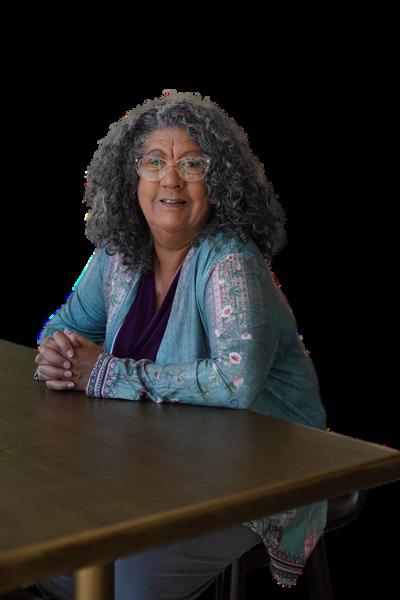
¡Serie de 8 clases! (2 por semana)
Todos los Martes y Jueves de Junio
6 p.m. PST / 9 p.m. ET a través de Zoom
con Patti Sanchez
www.DeafChildren.org
Obtenga más información sobre los recursos en español de ASDC aquí

Asesor profesional para personas sordas y con problemas de audición, sordociegas y personas con discapacidad auditiva | Creador de contenido | Capacitador en habilidades para la inclusión de personas con discapacidad | Orador y Facilitador | DEI
Nota: En este documento se utilizará el término “sordo” para referirse a las personas que se identifican como sordas, sordociegas, sordas con discapacidad o sordos parciales
Razones por las que algunos padres no aprenden ASL u otro lenguaje de señas
Puede haber varias razones por las que algunos padres no aprenden ASL u otro lenguaje de señas cuando tienen un hijo sordo. Estas razones pueden ser complejas y pueden incluir:
Preferencias de comunicación: Es posible que los padres tengan su modo preferido de comunicación, como el lenguaje hablado, y es posible que no vean la necesidad inmediata de aprender el lenguaje de señas. Esto podría estar influenciado por las normas y expectativas sociales
Algunos padres pueden tener una fuerte creencia en los métodos de comunicación oral, como la terapia del habla o el uso de audífonos e implantes cocleares, y pueden priorizarlos sobre el lenguaje de señas.

Realidad: Más del 90% de los niños sordos nacen de padres oyentes sin experiencia con la comunidad sorda o el lenguaje de señas americano, (ASL, por sus siglas en inglés) Se estima que el 70% de estos padres oyentes nunca aprenden ASL, según la Asociación Nacional de Sordos (National Association of the Deaf, por sus siglas en inglés).
Falta de concienciación: Es posible que algunos padres no sean conscientes de la importancia de la exposición temprana al lenguaje de señas para su hijo sordo Es posible que no entiendan completamente el impacto que la privación del lenguaje puede tener en el desarrollo general del niño
Recursos limitados: Aprender un nuevo idioma, especialmente uno visual y gestual como el ASL, requiere tiempo, esfuerzo y recursos Algunos padres pueden enfrentar desafíos prácticos o tener acceso limitado a materiales educativos o clases.
Creencia en la comunicación oral:
Barreras culturales y lingüísticas: Las barreras culturales y lingüísticas pueden contribuir a la falta de compromiso. Algunos padres pueden sentirse abrumados o intimidados por la perspectiva de aprender un nuevo idioma, especialmente si lo perciben como un desafío.
Diagnóstico tardío de la sordera: En los casos en que la
sordera se diagnostica más tarde, es posible que los padres no hayan recibido orientación temprana sobre la importancia de introducir el lenguaje de señas durante el período crítico de aprendizaje del lenguaje
Apoyo y educación limitados:
Es posible que algunos padres no tengan acceso a suficiente apoyo o educación sobre los beneficios del lenguaje de señas para los niños sordos. La falta de información puede obstaculizar su capacidad para tomar decisiones informadas
Estigma social:
Los estigmas sociales o los conceptos erróneos sobre el lenguaje de señas pueden influir en las decisiones de los padres Es posible que se preocupen por cómo percibirán a su hijo los demás o que teman un posible aislamiento social Es importante tener en cuenta que estas razones pueden estar interconectadas y que las circunstancias individuales varían. Fomentar la concienciación, proporcionar recursos y ofrecer apoyo a los padres puede ayudar a abordar algunas de estas barreras y promover un entorno más inclusivo y rico en lenguaje para los niños sordos Los programas de intervención temprana, los recursos educativos y la representación positiva de las lenguas de señas pueden contribuir a cambiar las percepciones y fomentar
una mejor comprensión de los beneficios de la lengua de señas para las personas sordas
Privación lingüística
La privación del lenguaje para niños sordos se refiere a una situación en la que un niño sordo carece de exposición a un idioma totalmente accesible y desarrollado durante su período crítico de aprendizaje del lenguaje, generalmente en los primeros años de vida (0 a 5 años). Esta privación puede ocurrir cuando un niño sordo no está expuesto a un lenguaje visual o de señas (como ASL) o a un lenguaje hablado con el apoyo adecuado (como el uso de audífonos o implantes cocleares).
El desarrollo del lenguaje es crucial para el crecimiento cognitivo, social y emocional, y la exposición temprana al lenguaje es esencial para el desarrollo general de un niño Si un niño sordo experimenta la privación del lenguaje, puede conducir a desafíos significativos en la comunicación, el rendimiento académico y las interacciones sociales
La prevención de la privación del lenguaje para un niño sordo implica una intervención temprana, proporcionar acceso a un idioma totalmente accesible y crear un entorno de apoyo para el desarrollo del lenguaje.
Es importante tener en
cuenta que cada niño sordo es único y que las intervenciones deben adaptarse a sus necesidades individuales. Los esfuerzos tempranos y consistentes para apoyar el desarrollo del lenguaje pueden mitigar significativamente el riesgo de privación del lenguaje y contribuir al bienestar y éxito general del niño.
Desafíos y obstáculos Los niños sordos que experimentan privación del lenguaje se enfrentan a una combinación de desafíos de exposición, cognitivos, sociales y lingüísticos que afectan colectivamente su desarrollo general A continuación, se explica cada uno de los desafíos:
Desafío de exposición: Definición: El desafío de la exposición implica una exposición limitada o ausente a un idioma totalmente accesible durante períodos críticos del desarrollo del lenguaje
Impacto: Sin una información lingüística consistente, los niños sordos pueden experimentar retrasos en la adquisición del lenguaje, lo que lleva a dificultades en la comunicación, la comprensión y la expresión
Desafío cognitivo: Definición: El desafío cognitivo se refiere a las dificultades en el desarrollo cognitivo, incluida la resolución de problemas, el pensamiento crítico y el crecimiento intelectual
general
Impacto: La privación del lenguaje puede obstaculizar las habilidades cognitivas, afectando la capacidad del niño para pensar críticamente, resolver problemas y participar en procesos cognitivos complejos
Desafío social:
Definición: El desafío social abarca obstáculos para formar conexiones, construir relaciones y participar en interacciones sociales debido a barreras de comunicación.
Impacto: La privación del lenguaje conduce al aislamiento social, ya que los niños sordos pueden tener dificultades para relacionarse con sus compañeros y expresarse socialmente, y navegar por los matices sociales, impactando su desarrollo social.
Desafío del lenguaje: Definición: El desafío del lenguaje implica dificultades para desarrollar un lenguaje totalmente accesible, como ASL u otro lenguaje visual.
Impacto: Los niños sordos pueden experimentar retrasos en las habilidades lingüísticas, lo que afecta las capacidades del lenguaje expresivo y receptivo Este desafío se extiende a las dificultades para leer, escribir y comprender conceptos complejos.
Impacto interconectado:
Exposición y cognitivo: La exposición limitada al lenguaje impide el desarrollo cognitivo, ya que el lenguaje es una herramienta crucial para los procesos cognitivos y el crecimiento intelectual
Exposición y social: Las barreras de comunicación debidas a los desafíos de exposición contribuyen a las dificultades sociales, lo que conduce al aislamiento social y obstaculiza el desarrollo social.
Exposición y lenguaje: La falta de exposición impide el desarrollo del lenguaje, lo que afecta las habilidades lingüísticas expresivas y receptivas, que son esenciales para una comunicación efectiva.
Cognitivo y lenguaje: Los procesos cognitivos dependen en gran medida del lenguaje. Los desafíos cognitivos pueden exacerbar las dificultades del lenguaje, y viceversa, creando una interacción compleja entre los dos
Abordar los desafíos:
Intervención temprana: la identificación temprana de la sordera y la intervención oportuna son fundamentales para abordar los desafíos de exposición. La exposición temprana a un idioma totalmente accesible es esencial para el desarrollo cognitivo y lingüístico.
Apoyo integral: Brindar
apoyo integral, que incluya intervenciones educativas, programas de desarrollo cognitivo y entornos ricos en lenguaje, es crucial para abordar los desafíos interconectados.
Inclusión social: Fomentar las interacciones sociales a través de entornos inclusivos, el apoyo entre compañeros y el fomento de actitudes positivas puede ayudar a mitigar los desafíos sociales Esto incluye la creación de oportunidades para la interacción con compañeros sordos y oyentes
Acceso lingüístico:
Introducir un idioma totalmente accesible, como el lenguaje de señas, y garantizar una exposición constante es vital para abordar los desafíos lingüísticos El acceso al idioma a través de programas educativos, recursos y comunidades de apoyo es clave
Al reconocer y abordar estas exposiciones: desafíos cognitivos, sociales y del lenguaje, se pueden hacer esfuerzos para crear un entorno más inclusivo y de apoyo para el desarrollo óptimo de los niños sordos que enfrentan la privación del lenguaje.
La privación del lenguaje para un niño sordo puede manifestarse de varias maneras y puede tener consecuencias significativas para su desarrollo general. Estos
son algunos signos y efectos observables de la privación del lenguaje en un niño sordo:
Vocabulario limitado: Dificultad para adquirir y utilizar un vocabulario Un niño sordo con falta de lenguaje puede tener un conjunto limitado de palabras y tener dificultades para expresarse de manera efectiva
Adquisición retrasada del lenguaje: Desarrollo más lento o retrasado de las habilidades lingüísticas en comparación con sus compañeros oyentes La falta de exposición a un idioma totalmente accesible puede obstaculizar la progresión típica de los hitos del lenguaje
Dificultad con la gramática y la sintaxis: Dificultades para comprender y utilizar las estructuras gramaticales y la sintaxis Un niño sordo privado del lenguaje puede exhibir errores en la construcción de oraciones y tener dificultades con reglas lingüísticas complejas
Modalidades de comunicación limitadas: Dependencia de gestos básicos, señalamientos o señas simples para la comunicación, en lugar de utilizar una gama completa de modalidades lingüísticas.
Aislamiento social: Dificultad para participar en interacciones sociales debido a desafíos en la comunicación. El niño puede tener dificultades para establecer conexiones con sus compañeros, lo que lleva a sentimientos de aislamiento
Dificultades académicas: Desafíos en entornos académicos, especialmente en materias que dependen en gran medida de la comprensión del lenguaje Leer, escribir y comprender instrucciones complejas puede ser particularmente difícil
Problemas de comportamiento: La frustración, el retraimiento o los problemas de comportamiento pueden surgir como resultado de dificultades de comunicación y desafíos para expresar necesidades y emociones.
Comprensión limitada de conceptos abstractos: Dificultad para comprender conceptos e ideas abstractas, ya que la privación del lenguaje puede obstaculizar la capacidad del niño para participar en el pensamiento y el razonamiento de orden superior.
Falta de habilidades narrativas: Desafíos en la narración de historias y la transmisión de información de manera coherente y organizada.
El niño puede tener dificultades para narrar experiencias o eventos de manera efectiva
Dependencia de las señales visuales: Mayor dependencia de las señales visuales y el contexto para comprender la información, ya que la información auditiva no está fácilmente disponible. Abordar la privación del lenguaje en un niño sordo implica una intervención temprana, la exposición a un lenguaje totalmente accesible (como el lenguaje de señas) y apoyo educativo personalizado Es crucial reconocer los signos desde el principio y proporcionar intervenciones que faciliten el desarrollo del lenguaje, la participación social y el crecimiento cognitivo general
Adquirir el lenguaje de señas americano (ASL) Ayudar a un niño sordo a adquirir al ASL implica crear un entorno que apoye la exposición, la práctica y el refuerzo de las habilidades del lenguaje de señas Estas son algunas estrategias para ayudar a un niño sordo a adquirir al ASL:
Comenzar temprano: Introducir ASL lo antes posible La exposición temprana al lenguaje es crucial para el desarrollo, y proporciona una base sólida para la comunicación
Participar en el aprendizaje visual y táctil: Use métodos de aprendizaje
visual y táctil para enseñar signos de ASL Incorpore ayudas visuales, ilustraciones y actividades prácticas para mejorar la comprensión.
Utiliza objetos cotidianos: Enseñe signos relacionados con objetos y actividades cotidianas Esto ayuda al niño a conectar las señales con sus experiencias diarias, haciendo que el aprendizaje sea más práctico y relevante
Exposición constante: Proporcione una exposición constante al ASL incorporándolo a las rutinas diarias, como durante las comidas, la hora de jugar y la hora de acostarse La constancia es clave para la adquisición del lenguaje.
Juego interactivo:
Utilice el juego interactivo como una oportunidad para introducir y practicar las señas de ASL. Incorpore letreros en juegos, narración de cuentos y otras actividades interactivas
Utilizar recursos
multimedia: Utilice recursos multimedia, como videos de ASL, libros con ilustraciones en lenguaje de señas y aplicaciones educativas diseñadas para aprender ASL. Estos recursos pueden complementar el aprendizaje práctico
Inscríbete en clases de ASL: Considere inscribir al niño
en clases de ASL diseñadas específicamente para niños Estas clases a menudo incorporan juegos, narración de cuentos y actividades interactivas para que el aprendizaje sea agradable
Involucre a toda la familia: Anime a toda la familia a aprender y usar ASL. Cuando todos los miembros de la familia están involucrados, se crea un ambiente de apoyo para el desarrollo del lenguaje del niño.
Modelos a seguir para sordos:
Preséntele al niño modelos sordos que usan ASL La exposición a personas que dominan el lenguaje de señas puede inspirar y proporcionar valiosos modelos lingüísticos
Práctica en entornos sociales: Cree oportunidades para que el niño use el lenguaje de señas en entornos sociales Esto puede incluir interacciones con otros niños sordos, participación en eventos de la comunidad sorda o participación en entornos educativos inclusivos
Fomentar la expresión: Anime al niño a expresarse usando ASL. Esto implica crear un entorno en el que el niño se sienta cómodo utilizando el lenguaje de señas para transmitir sus pensamientos, necesidades y emociones.
Celebre los hitos: Celebre los hitos del ASL del niño El refuerzo positivo y el reconocimiento del progreso pueden motivar al niño a continuar aprendiendo y usando ASL.
Paciencia y apoyo: Sea paciente y brinde apoyo continuo Aprender un idioma lleva tiempo y cada niño progresa a su propio ritmo. Anime al niño, celebre los éxitos y ofrézcale apoyo durante los desafíos
Recuerde que cada niño es único, por lo que es importante adaptar el enfoque en función de los intereses, las preferencias y el estilo de aprendizaje del niño La creación de un entorno rico en lenguaje y la incorporación del lenguaje de señas en varios aspectos de la vida del niño contribuirá a su adquisición exitosa del lenguaje de señas americano
En resumen, el lenguaje no es solo un medio de comunicación para los niños sordos; Es la clave para su desarrollo cognitivo, social, emocional y académico. Proporcionar a los niños sordos acceso a un lenguaje totalmente accesible, ya sea hablado o por señas, es esencial para liberar todo su potencial y garantizar una vida plena e inclusiva.
Referencia:
Un emotivo episodio de New Amsterdam sobre el síndrome de privación del lenguaje, este conmovedor episodio de New Amsterdam es un drama médico cautivador Este episodio en particular, titulado “Give me a Sign”, subraya maravillosamente la importancia de la comunicación para las personas con diferencias auditivas
En este episodio (Temporada 5, Episodio 6), conocemos a Jael, un niño sordo de cinco años. Los padres de Jael revelan que perdió la audición a los 12 meses debido a una enfermedad. Se les aconsejó que no le enseñaran el lenguaje de señas, ya que creían que podría obstaculizar el desarrollo del habla A pesar de sus esfuerzos, el vocabulario de Jael sigue siendo limitado, lo que provoca frustración y aislamiento
El Dr Iggy Frome cuestiona este enfoque, citando que un niño típico de dos años sabe alrededor de 150 palabras Diagnostica a Jael con el Síndrome de Privación del Lenguaje, haciendo hincapié en el período crítico de adquisición del lenguaje.
Los padres se sorprenden de no haber sido informados antes El Dr Frome critica el sesgo del campo de la medicina y los anima a considerar la posibilidad de proporcionar a Jael un lenguaje propio
a Dra. Frome presenta a la familia a la Dra. Wilder, una cirujana sorda, mostrando su éxito en el departamento de oncología utilizando el lenguaje de señas americano (ASL). Enfatiza cómo el lenguaje de señas transformó su vida, dejando a Jael asombrada por su potencial
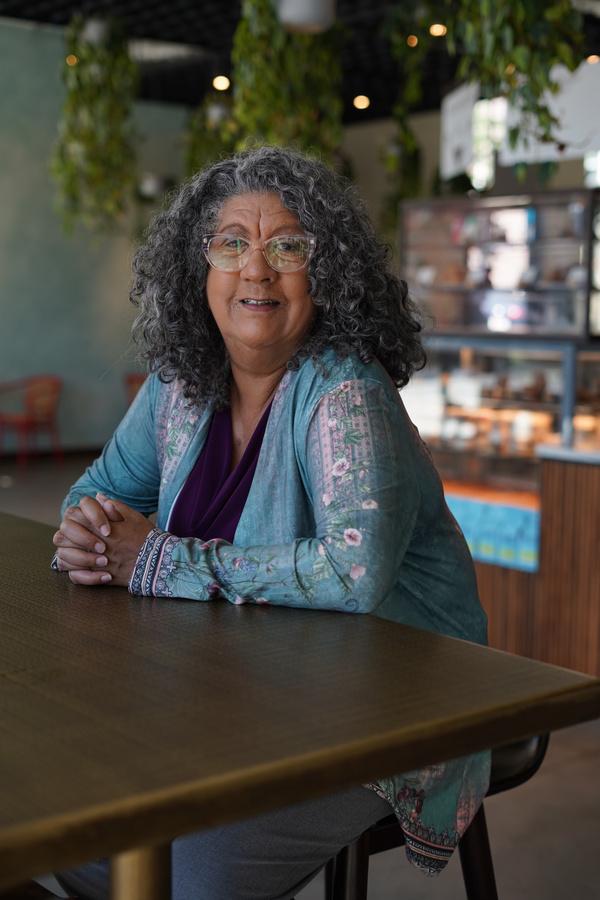
Patti Sanchez de Brooklyn, Nueva York, es nacida de padres puertorriqueños continentales, Patti es sorda y gerente de los Servicios de Empleo DHH para la comunidad sorda y con pérdida auditiva, proveedora de Rehabilitación Vocacional de Florida. Patti recibió una maestría en Administración de Empresas con concentración en Recursos Humanos de la Universidad de Phoenix y un B.S. en Administración de Empresas con especialización en contabilidad, recursos humanos y marketing de St Francis College de Brooklyn, Nueva York Patti es una intérprete trilingüe sorda calificada y educadora
Es una creadora de contenido de YouTube para el plan de estudios de empleo de ASL.
En su tiempo libre, Patti disfruta pasar tiempo de calidad con dos perritos, Luna y Korra También se ofrece como voluntaria para cualquier pequeño proyecto relacionado con el abuso y el abandono de los animales Patti encuentra que ayudar a los demás es una experiencia muy gratificante


Learn ASL

Learn ASL with ASDC
ASL for Spanish Speakers

The American Society for Deaf Children regularly hosts online classes, workshops, and groups for Latino parents and families with deaf children. ASL classes for Spanish speakers and the monthly workshops are designed to help Latino parents navigate through learning ASL, how to work with schools, empowering their deaf child and their siblings, addressing mental health wellness, and many other topics. Join us!
All classes and workshops are held in Spanish.
Questions? Please email Yiesell at yiesell@deafchildren.org
NEW CLASS!!

SPANISH SPEAKERS
Class Series! (2 per week)
esdays and Thursdays in June
Learn more about ASDC’s Spanish Resources here
m PST / 9pm ET via Zoom
m. PST / 9 p.m. ET a través de Zoom
with Patti Sanchez
DeafChildren.org

Nota: Esta versión en inglés difiere de la versión en español para mejorar la fluidez y la comprensión.*

Disclaimer: The English version of this article has been modified for readability and flow. While efforts have been made to maintain accuracy, some nuances may differ from the original Spanish version.
Imagine a world where language is not just a form of communication but the very key to unlocking a child's cognitive, social, emotional, and academic potential For parents of deaf children, this world often presents unique challenges and opportunities In this guide, we delve into the importance of language, the barriers faced by deaf children, and strategies to support their language acquisition journey
Understanding Deafness: Breaking Down Barriers
More than 90% of deaf children are born to hearing parents who may lack experience with the Deaf community or American Sign Language (ASL)
Astonishingly, around 70% of these parents never learn ASL, according to the National Association of the Deaf This lack of exposure can stem from various reasons, including limited awareness, communication preferences, resource constraints, belief in oral communication, cultural and linguistic barriers, late diagnosis of deafness, limited support and education, and social stigma.
It's crucial to acknowledge the interconnected nature of these barriers and the diverse circumstances of each family. By fostering awareness, providing resources, and offering support, we can begin to address these challenges and create a more inclusive
and language-rich environment for deaf children,
The Perils of Language Deprivation
Language deprivation, a phenomenon where deaf children lack exposure to a fully accessible language during critical developmental periods, poses significant risks to their overall well-being. Without access to a linguistic foundation, deaf children may encounter difficulties in communication, academic achievement, and social interactions. To prevent language deprivation, early intervention, access to a fully accessible language, and a supportive environment for language
development are essential
Navigating Challenges: A Roadmap for Support
Deaf children experiencing language deprivation encounter a multitude of challenges, spanning exposure, cognitive, social, and language domains. From limited linguistic input to difficulties in forming connections and grasping complex concepts, these challenges underscore the importance of early intervention and comprehensive support
By addressing exposure challenges through early identification and intervention, providing comprehensive support tailored to individual needs, fostering social inclusion, and ensuring access to a fully accessible language, we can mitigate the impact of language deprivation and promote optimal development in deaf children
Empowering Language
Acquisition: Strategies for Success
Acquiring American Sign Language (ASL) is a journey that requires a supportive environment, consistent exposure, and tailored strategies. From starting early and engaging in visual and tactile learning to involving the entire family and celebrating milestones, there are numerous ways to facilitate ASL acquisition in deaf children.
By embracing these strategies and recognizing
the unique strengths and needs of each child, we can pave the way for a more inclusive and fulfilling future for deaf children.
In the poignant episode "Give Me a Sign" from New Amsterdam, we witness the transformative power of language for individuals with hearing differences
Through the story of Jael, a deaf boy diagnosed with Language Deprivation Syndrome, we are reminded of the critical importance of early language exposure and support
As parents, educators, and allies, let us come together to unlock the potential of deaf children through language
By breaking down barriers, navigating challenges, and empowering language acquisition, we can create a world where every child has the opportunity to thrive
References:
A heartfelt episode of New Amsterdam about Language Deprivation Syndrome, This moving episode of New Amsterdam, is a captivating medical drama. This particular episode, titled "Give Me a Sign," beautifully underscores the significance of communication for individuals with hearing differences
In this episode (Season 5, Episode 6), we meet Jael, a fiveyear-old deaf boy Jael's parents reveal he lost his hearing at 12 months due to illness. They were advised against teaching him Sign Language, believing it might hinder speech development. Despite their efforts, Jael's vocabulary remains limited, causing frustration and isolation
Dr Iggy Frome questions this approach, citing that a typical two-year-old knows about 150 words. He diagnoses Jael with Language Deprivation Syndrome, stressing the critical language acquisition period.
The parents are surprised they weren't informed earlier Dr Frome criticizes the medical field's able-bodied bias and encourages them to consider providing Jael with a language of his own.
Dr. Frome introduces the family to Dr. Wilder, a deaf surgeon, showcasing her success in the oncology department using ASL He emphasizes how sign language transformed her life, leaving Jael in awe of its potential

A Brooklyn, New York native born to mainland Puerto Rican parents, Patti Sanchez is Deaf and a Manager for DHH Employment Services for the deaf and hard of hearing community, provider with Florida Vocational Rehabilitation Patti received a master’s degree in Business Administration with a concentration in Human Resources from the University of Phoenix and a B S in Business Management with a minor in accounting, human resources, and marketing from St. Francis College of Brooklyn, New York.
She is a qualified deaf trilingual interpreter and an educator She is a YouTube content creator for ASL Employment Curriculum
In her spare time, Patti enjoys spending quality time with two 4legged doggies, Luna and Korra. She also volunteers for any small projects related to the abuse and neglect of animals Patti finds helping others to be a very rewarding experience


The American Society for Deaf Children's ASL Stories Directory makes it easy to find hundreds of free videos of ASL retellings of your child's or student's favorite books. Research shows that reading and signing stories together helps promote essential language development and literacy skills for ALL children: deaf, hard of hearing, and hearing.
Use our ASL Stories Directory to quickly find stories by age or by the book's title. Make the most of signing and reading with your child! Visit our directory today!


This comprehensive article aims to provide valuable insights into understanding and supporting the deaf community, drawing from both personal experiences and scholarly research to encourage empathy, inclusivity, and advocacy.
Navigating the world of people who are deaf or hard-of-hearing is an enlightening journey, one that is rich in culture, language, and unique perspectives. As a profoundly deaf woman who grew up in a hearing home, was mainstreamed, did not learn sign language until much later in life, and also proudly raised two children one hearing and one hard-of-hearing I offer insights into this vibrant community, blending personal experiences with research-based facts to foster understanding and inclusivity
Deafness transcends the absence of sound; it encompasses a rich tapestry of language,
culture, and tradition American Sign Language (ASL), our primary means of communication, is a complete visual language with its grammar and nuances While I do not use ASL as my primary means of communication, I am a strong advocate for it and encourage its integration into our everyday life ASL should be just as accessible as spoken English and taught to all kids, hearing and deaf, from day one. Understanding ASL is pivotal in grasping the depth of the deaf experience and fostering inclusivity Research by Padden and Humphries (1988) highlights the significance of ASL as a distinct linguistic system, emphasizing its role in shaping deaf identity and culture.
Deaf individuals bring unique talents and perspectives to society, yet societal barriers often impede access to information and resources

Embracing assistive technologies such as captioning, video relay services, and cochlear implants can dismantle these barriers, fostering a more accessible world for all. Research by Leigh, Maxwell-McCaw, and BatChava (2000) underscores the importance of addressing systemic barriers to education, employment, and healthcare faced by deaf individuals, advocating for inclusive policies and technologies.
Empathy is like the glue that binds the hearing and deaf communities together. It's about understanding and appreciating each other's experiences without judgment Instead of labeling deaf individuals as "disabled," let's celebrate their unique abilities and perspectives After all, there's so much diversity within the deaf community it's like a beautiful tapestry woven with different threads of culture and language.
Research by Gernsbacher and Pripas-Kapit (2012) suggests that empathy training can work wonders in improving attitudes towards individuals with disabilities, fostering inclusivity and understanding. I've always cringed at the "disabled" label it just doesn't capture who I am It takes time, accessibility, understanding, and empathy for everyone to realize that labels don't serve us. Let's focus on what we can do, rather than what we can't
Creating an inclusive environment at home is crucial for the development and comfort of deaf children Learning sign language together, encouraging bilingualism, and fostering open communication are pivotal steps in fostering a supportive atmosphere Additionally, teaching hearing children to be allies and advocates for the deaf community nurtures empathy and understanding
from an early age Lane, Hoffmeister, and Bahan's (1996) research underscores the significance of family involvement in fostering deaf children's language and cultural development, highlighting the pivotal role of parental support in shaping positive outcomes I consider myself fortunate to have grown up in a home where my parents were staunch advocates for equity and accessibility, especially at a time when accessibility and ASL were not widely accepted. Their dedication to creating an inclusive environment changed everything for me It taught me the value of inclusivity and the power of advocacy. Their unwavering support laid the foundation for my journey, and I am committed to providing the same level of support and advocacy for my children. I strive to create an environment where they feel valued and empowered to embrace their identity, regardless of how well they hear
Comprehending deafness as a hearing parent is a multifaceted journey that requires embracing diversity, breaking down barriers, and championing equal opportunities for all, regardless of hearing ability Similarly, as a deaf parent, understanding the hearing world demands the same level of commitment to inclusivity and empathy By integrating these practices into our daily lives, hearing parents can create nurturing and inclusive
environments at home while also becoming empathetic allies to the deaf community. It's a continuous process of learning, advocacy, and support that is essential in fostering a world where everyone feels valued, heard, understood, and included
References:
Padden, C , & Humphries, T (1988) Deaf in America: Voices from a culture Harvard University Press.
Leigh, I. W., MaxwellMcCaw, D , & Bat-Chava, Y (2000) Challenges facing deaf individuals: Psychological and sociological perspectives. Journal of Deaf Studies and Deaf Education, 5(3), 215229
Gernsbacher, M A , & Pripas-Kapit, S R (2012) Who’s missing the point? A commentary on claims that autistic persons have a specific deficit in figurative language comprehension Metaphor and Symbol, 27(1), 93-105
Lane, H., Hoffmeister, R., & Bahan, B. (1996). A Journey into the Deaf World DawnSignPress
Marschark, M , & Hauser, P C. (2012). Deaf cognition: Foundations and outcomes. Oxford University Press.
About Wendy:
Wendy's life journey, from childhood adversity to leadership challenges as a hard-of-hearing/deaf woman, fuels her commitment to championing marginalized groups and promoting inclusive practices. Through "You Can't Yell at the Deaf Girl" and diverse initiatives, she breaks communication barriers with empathy and innovation Wendy's passion extends to empowering women, crafting inclusive policies, and fostering selfworth Her downtime? Filled with nature, volunteering, and cherished moments with family, Wendy embraces life's adventures with joy.

what
-Noam Chomsky
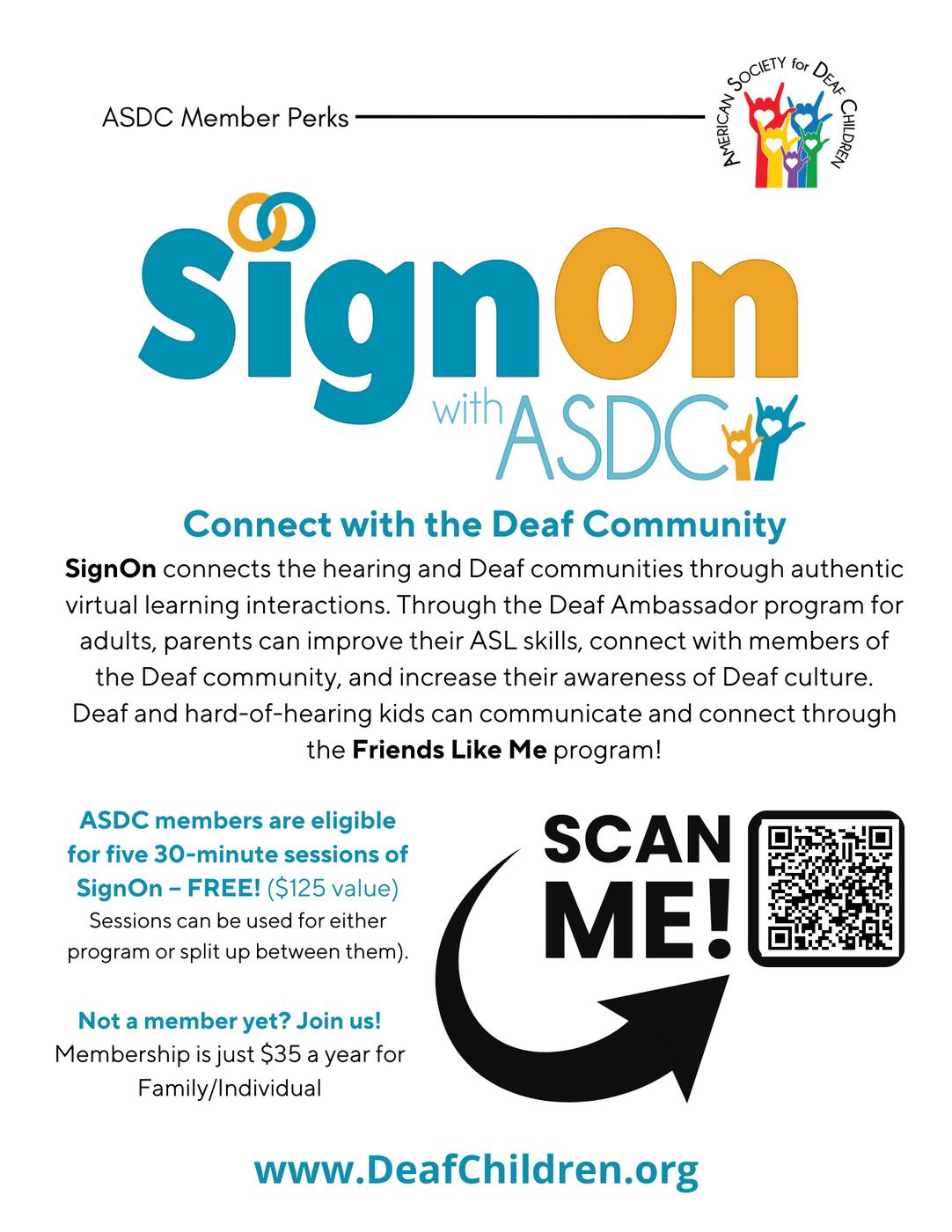

It was May 2012 when I asked my Deaf, K-3 grade class what they planned to do when they graduated high school. Ryan, a third grader with piercing blue eyes, surprised me with his response “I’ll become hearing?” Seeing my expression, he changed his question, asking matter-offactly “Then I’ll die?”
I’d read and been told about this kind of statement by Deaf students in mainstream schools, who often attend as “solitaires,” and never meet any other Deaf people on campus. But I hadn’t quite believed it until that moment in the classroom The Deaf program staff at the public school where I taught were all female, and only a couple of us were Deaf. Ryan thought he’d either become hearing or die at age 18 because, having barely ever met a Deaf man, he didn’t have ample proof they existed.
This was in 2012 Since then, there have been some changes in our landscape
IIn addition to increased access via technology and social media, we are currently experiencing an explosion of Deaf representation in Hollywood and beyond. We are popping up on TV, movies, Broadway, American Sign Language (ASL), the news, and social media
Deaf athletes and ASL are also making increasing appearances in the world of sports But as fans watch eagerly to see what hearing football player DK Metcalf will say next in shockingly fluid ASL, and the Superbowl excitedly features the national anthem and half-time performances in ASL, my mind constantly goes to Deaf children, like Ryan. Will there be any real impact on them?
Harlan Lane says, “Education is the battlefield where linguistic minorities win or lose their rights.” As a teacher in a mainstream school, I saw striking levels of ignorance and both overt and covert audism among
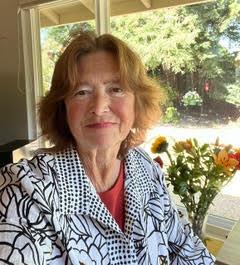
administration and staff about my Deaf students and what benefitted them linguistically, academically, and psychologically.
Now, as we witness mainstream attitudes towards the Deaf improving with our recent boom in the media, we need attitudinal changes in mainstream schools as well.
Outside of schools, the Hollywood impact is considerable Certainly, there’s still a lot of ignorance and discrimination to be encountered in daily life, but when I’m out and about in public spaces, I’m delighted by how often I encounter hearing people who sign a little, and have a very open, friendly attitude when I tell them I’m Deaf In November 2022, a survey revealed 79% of Deaf people felt there was a significant increase in our representation in the media I believe this is partly responsible for the increased positivity among the hearing public
And representation is powerful I saw that firsthand when I was teaching On the rare occasions when I was able to dig up a video or book by a Deaf person, my students went ballistic with excitement, and a live Deaf visitor put them over the moon In 2021, Rose Ellis Ayling won the major TV show Strictly Come Dancing in the UK, and there was an 800% increase in Britons googling where they could learn sign language One mother posted on social media that her Deaf daughter was freshly energized; feeling she, too, could become a professional dancer The child’s reaction was not uncommon.
But will all this beauty penetrate the thick walls of schools and medical offices where hearing parents are still routinely directed to choose either speech/hearing or sign language, rather than both?
When CODA, with its mostly Deaf cast, won a Best
Now, as we witness mainstream attitudes towards the Deaf improving with our recent boom in the media, we need attitudinal changes in mainstream schools as well.
Picture award at the Oscars, my hopes soared.
On TV, Marlee Matlin, Troy Kotsur and Daniel Durant were dressed to the nines, interpreters were everywhere and Deaf talent and success were stunningly obvious. When Robert DeNiro, Wesley Snipes, Meryl Streep, and Halle Berry stood up with hundreds of their fellow actors and did the Deaf applause, I almost sobbed. I felt parents of Deaf children, many of whom would watch the Oscars, would finally be somewhat vaccinated against the frequent negative messaging they get about ASL and Deaf culture.
However, when it comes to recommendations and decisions made between parents and school administration about key issues like placement, and communication modes or access, I have seen since; that there has been little impact Not only that, but there is likely even a backlash.
Dr Leala Holcomb, Research Assistant Professor of language and literacy in deaf education at the University of Tennessee, put it this way: “Even though Hollywood movies may include signing characters, professionals tell these families that with medical, technological, and educational advancements, their deaf children can learn to hear and speak and do not need signed language Those signing deaf people in Hollywood are " a thing of the past" Look at how isolated those
Deaf people are. Your child doesn’t need to live like that ”
This rings true to me; I can easily imagine such “othering” going on, actively, in mainstream school settings Because I saw it, as a teacher The objective of othering is strategic It deliberately puts artificial distinctions and distance between people. In mainstream schools, Deaf students are often told they should not hang out with each other so much but rather mingle with hearing students. It is emphasized by staff, to some students, that they are not Deaf, but hard-ofhearing, and that Deaf schools are inferior
We are all guilty of confirmation bias, where we seek proof of things we already believe in, and it’s all too easy to ignore evidence to the contrary, especially when it is largely un-opposed. The majority of staff at mainstream settings are hearing, (85% to be more specific, in the study shown here; and this still reflects mostly Deaf schools.) Obviously, there is often little, if any, Deaf input there Thus, certain beliefs and value systems about the value of assimilation, VS Deaf pride, are strongly reinforced among staff, with little counterbalance. A Deaf teacher, Michael Lupo, told me “From my experience teaching DHH children in the public schools, hearing professionals would always ask and value other hearing professionals opinions and recommendations on DHH
children. No matter how educated and experienced I am, it didn't matter to them I always wondered what more they needed from me for my professional opinions to be heard.”
When I taught in a public school for ten years, and then at a Deaf school, I was shocked enough by the experience to write a book about it. In my book, “The Butterfly Cage,” I share the dramatically different approaches and results at these two schools and the stark difference in how my former students navigate their young adulthood after their educational journeys One thing that’s been interesting to me, and also that triggered my desire to write this article, is that based on the responses of both hearing and Deaf readers of my book it’s clear to me that many are under the presumption that “things are better now. ” They express surprise about the true stories I tell in my book “It was still happening in 2013?” they say in disbelief, about educational oppression. It gives me no pleasure to say, but I feel it is essential to say, yes, and it’s still happening TODAY
I believe our appearances in the media give people this false impression. Our society is so celebrityobsessed that simply the fact that we are seen on the big screen is enough to be misleading, let alone when we are successful or bad-ass, like Echo’s fantastic Deaf-disabled Indigenous character in a show packed with signing characters
The exposure is terrific, but it’s important for the public to also be aware that our battles to keep Deaf schools open, to fight legal battles for equitable education, and the persistent representation of hearing devices being total solutions are ongoing
Cases in point are the 2023 Supreme Court case of Miguel Luna Perez, a Deaf boy who was found to have not had language access nor made academic progress in 12 years at a public school. Or the recent ACLU DE lawsuit, where the ACLU of Delaware was guided by an LSL contingent to sue because of “ overplacement of Deaf students in Deaf schools,” only backtracking somewhat after 20,000 signatures on a strongly oppositional petition from the Deaf community. And more examples that crop up daily.
In contrast to the confounding lack of progress we are making in education, in Hollywood things are changing fast! In 2023, there was a fantastic panel produced by Deafwest and NRG In it, Lauren Ridloff explained that she was told around 2017 not to pursue acting, as it’s a tough path for a Deaf person In many ways, this continues to be true But since then she has starred in several big hits including The Sound of Metal and Marvel.
Just a couple of years ago, when a Deaf character appeared on one of my favorite TV shows, I cringed 32
Based on my past experiences, I was afraid the show would be ruined for me; that the focus on the Deaf character would be medical or offensively used as comedy fodder, or that they’d repeat my biggest pet peeve; the Deaf character shown as lipreading perfectly. However, it doesn’t take much to shift the needle emotionally, and my expectations have risen
Different shows speak personally to different people. For me, this TV show; New Amsterdam, was pivotal, with its flabbergasting portrayal of a Deaf doctor In one scene, a therapist told a couple their Deaf child was acting out due to language deprivation He recommended the parents sign and that their son attend a Deaf school, where he’d be in a language-rich environment. It was astonishing to see this on national TV
Later episodes showed the Deaf doctor turning down romantic overtures from the show’s main character; a hearing doctor who, while wonderful in many ways, was not fluent in ASL and didn’t understand her culture. Next, the show had the Deaf character being asked to manage a Deafrun hospital, an idea so radical I almost fell over
Popular reality shows, too, like Dancing with the Stars, Big Brother, The Amazing Race, The Circle and in Britain, the Great British Baking Show and Strictly Come Dancing, to name
just a few, are increasingly featuring Deaf contestants Lauren Ridloff referred to reality shows as a “gateway;” an entry point to more meaningful work, whether in the acting industry or in general
Indeed, after Rose Ellis Ayling won Strictly Come Dancing, she went on to get a starring role and was the executive producer of Will Dean’s Dar Pines, in the Tuva Moodyson Mystery series.
In the context of contests, being Deaf is normalized Hearing viewers get a sense of the Deaf contestant as a person; the focus is taken off their being Deaf, as a plot line, and placed on the required skill, or topic of the show
Tasha Stones, on the latest season of the Great British Baking Show, is a great example. A tall, confident young woman who wears a cochlear implant over her nut- brown hair, she switched freely between signing and speaking on the show. She was clear in attributing her ability to participate successfully to the presence of an interpreter, and I loved how she kept the judges and other contestants focused on her formidable, creative baking skills, rather than the Deaf aspect Tasha was simply there to win the show, and if she educated or provided healthy representation to Deaf children worldwide, so be it.
Hollywood and TV have such a huge amount of influence on our society,
that with each appearance of a confident, successful Deaf person on screen, some magic happens. Like healthy roots growing underground, the roots will emerge and flower in unrelated places, for the betterment of everyone
But about one in twenty people have less than perfect hearing, so we are still extremely underrepresented in the media And scarcity still colors our experience. In 2024, we are experiencing our “firsts.”
In 2022 it had been 93 years since the creation of the Oscar awards, when Troy Kotsur was the first Deaf man to win an Oscar. Jade Bryant was the first Deaf Black woman to graduate from the prestigious acting school Tisch, the first to direct a documentary and TV series, and now is the first to run her own acting school, Deaf talent organization, and film company In 2023 Keivonn Woodard was the first Black Deaf actor to be nominated for an Emmy award for his work in the TV show “The Last of US.” And so on.
Deaf representation in video games, animation, and live theater has lagged behind other forms of media,but that too is rapidly changing now Our presence on Broadway shows, video games, and animated shows has expanded in those spaces recently, just one example is Natasha Ofili, who played a Deaf animated character for PlayStation 5, and was also on the animated TV show “Undone ”
Culture is leaning increasingly towards more diversity in Hollywood, with movements, Oscarsowhite and Time’s Up, revealing systemic discrimination. And Deaf actors are riding that wave. But not to the degree that we are coming anywhere near to including ALL variations of the Deaf experience According to David Kurs, viewers are twice as likely to see a white Deaf person as to see a Deaf person of color on TV
By Margarita Perez.fictionalized depictions of Deaf characters on TV and in movies should carry a message; similar to the disclaimers one sees at the end of documentaries. It would be a very clearly written, vivid block of text shown after every show, to remind the viewer that the story they saw was only ONE version of our complex community Scrolling slowly, it would share some stark facts and statistics
The text might go something like this:
It is the fourth most used language in the US, popular among hearing people as well as Deaf. Many learn it in high school and college to meet foreign language requirements 47% of the vast number of Deaf people who had cochlear implant surgery in childhood stop using them in adulthood
established relationships within the industry would be important to this process; no easy thing in an industry where we are faced with communication barriers, and one must grow a resume and connections without the benefit of having a resume or connections.
Photography by Francois MercerIn reality, we comprise a huge range of intersectionality; we vary in ethnicity, sexuality, socioeconomic, educational status, age of losing hearing, Deaf identity or lack thereof whether we speak or not, whether we use listening devices or not, and so on
Lauren Ridloff said: “Deaf people are often both excited when they see Deaf characters on screen, and disappointed if the character is not like them ” I felt that way about Matt Klotz on Big Brother He went far on the show, and had charisma. I was glad for the positive exposure, but I was also very worried about hearing viewers taking an inaccurate and harmful message from him; i.e.: the impression that all Deaf people can speak and lipread effortlessly, since he seemed to When people meet Deaf people in real life, they connect us unconsciously with characters they’ve seen on TV.
To avoid such harmful generalizations, I believe all
Remember, this character shows only one way of being Deaf The Deaf population is extremely diverse. Only 2% of Deaf people worldwide have access to education via sign language
85% of Deaf and hardof-hearing students in the US attend mainstream schools. Most administrators are untrained in Deaf education
95% of parents of Deaf and hard-of-hearing kids don’t sign, and many teachers of the Deaf don’t either 70% of these children are severely languagedeprived Language-deprivation often has lifelong consequences American Sign Language (ASL) is a comprehensive, unique language with features equal to any other language. Its impact on the human brain and brain development is equal to that of any other language
You have heard of racism and sexism Another word you should know is AUDISM. It refers to the idea that hearing and speech are superior to being Deaf or signing It is often an unconscious and unexamined bias. Deaf culture is a source of pride and positivity for many thriving, bilingual hard-of-hearing and Deaf people
A message like this would help connect entertainment with reality, allowing viewers to see the bigger picture; the real-world issues If hearing people saw these messages repeatedly, they’d begin to build up resistance to the sometimes dismissive framing towards ASL and Deaf identity by their child's teacher, SLP, or principal, at the next IEP meeting.
Of course, Deaf people should be the ones writing this text Networking strategist James Poteet suggests multiple Deaf agencies share the task, ideally coming up with a balanced message that satisfies all It would then be pitched to Netflix, Pixar, Warner Bros, etc Poteet makes a good point that
The visibility of Deaf authors and books, too, is increasing these days, slowly but surely Some people have talked to me about their dreams of writing books, after seeing mine. They have a sense of “if she can do it, so can I,” and I agree I’m excited by these upcoming writers and their books, because their writing is fantastic, and their stories very important; just as the diversity of characters is needed in Hollywood, it’s true of Deaf literature too
The passionate words of Dr. Paddy Ladd, in 2013, lit a fire under me to speed up my work “We have many books written about us by hearing people Now, it’s time to write our own stories.” It’s not an easy process; hearing gatekeepers are no joke Perhaps the Deafer a book is, the harder it is to get past the door But as in all forms of media, with our work, we uplift each other. Sara Novic had the rare breakthrough of being published by a large mainstream publishing house, and her success will help pave a path for other Deaf writers, as publishers see there is interest in Deaf-themed books beyond the Deaf community
mainstream schools, where administration is 99 9% hearing, in films and TV, as Lauren Ridloff explained. “Those at the table are all [hearing] white men. Deaf people need to have a seat at the table, PRE-show, PRE-planning, making the decisions ” There is a big difference between tokenism, where a minority is placed in front of the screen without having any real power, and actual, structural change where members of that minority are running the show.
Global DEIB Impact manager Zara Chaudary says “It doesn’t matter what policies you have in place, if your mindset or intention isn’t right…change won’t properly happen….. Companies are trying to attract diverse talent, without creating an inclusive environment. That means when diverse talent comes, they don’t feel like they belong ” For Deaf people, this includes an extra, and vital, layer of providing accessibility Deaf actress Raven said, “It requires willingness and creativity to make shows accessible to us ”
While willingness is often an issue, the information is not hard to find. The NAD has put out an excellent list of rules for the media, online But so often access is granted to us only in a halfhearted fashion Recently, I was surprised to find that on the iPhone app Apple Fitness workout instructors all use some sign language in their introductions But after a few sentences, they drop their signs and just
talk For the remainder of their workouts, they sign random bits and pieces To outsiders, it looks cool; like they’re providing access to Deaf people. But in reality, I’m guessing to most Deaf people it feels annoying and fake
Problematic access issues exist in audio-centric social media, too, and in providing access on the big screen, many assume that captions are adequate for all Deaf people. That too, is beginning to shift, and it is hugely appreciated. The first Warner Bros movie to feature ASL as a language option, Barbie with ASL was released recently, in January 2024, and was met with rave reviews.
Hollywood is beginning to get it right The hearing crew and cast of Marvel’s Echo studied ASL classes, seriously. Yes, it’s ironic that this happens more easily in the realm of entertainment than for Deaf children who desperately need visual language input yet are so often denied it. But other societal changes have been incremental, too. If Hollywood can penetrate people’s hearts deeply enough, perhaps the trickledown effect; going, oddly, from the realm of entertainment to the more life-changing one of education, will be impactful and positive
A 2022 survey by NRG and Deaf West found that 43% of hearing people had watched media with Deaf characters But how do we reach the other 57%? In 2023, Nielsen reported that
more than 113 million people tuned in to watch the Superbowl As I write this, the NAD has just announced the upcoming Deaf and ASL presence at the 2024 Superbowl Every year, excitement about it builds up only to crash in a furor of disappointment afterward when Deaf viewers find themselves having to follow complicated directions to access anything longer than 30 seconds of seeing the Deaf performers.
What if all sports events featured the national anthem in ASL and all televised sports showed the performance, by Deaf performers, for the full duration of the song, in split screen equally exhibiting the hearing and the Deaf performers?
This would result in such an infusion of Deaf pride and the robust beauty of ASL into living rooms all over the US; many of which will contain Deaf children and their families Imagine the excitement of those children, the power of the messaging, and the positive shift in how the Deaf children would be regarded at school the next day by their peers Instead of being bullied or looked down on as the “deaf kids” they might be looked up to, with respect, due to the cool Deaf representation on TV
The impact would be huge! If more Deaf adults applied for and were hired by mainstream settings, the consistent influx of fluent ASL language models and
“What if all sports events featured the national anthem in ASL and all televised sports showed the performance, by Deaf performers, for the full duration of the song, in split screen equally exhibiting the hearing and the Deaf performers?”
“Perhaps seeing more Deaf people on TV will offset the scarcity so many of our children experience in the mainstream.”
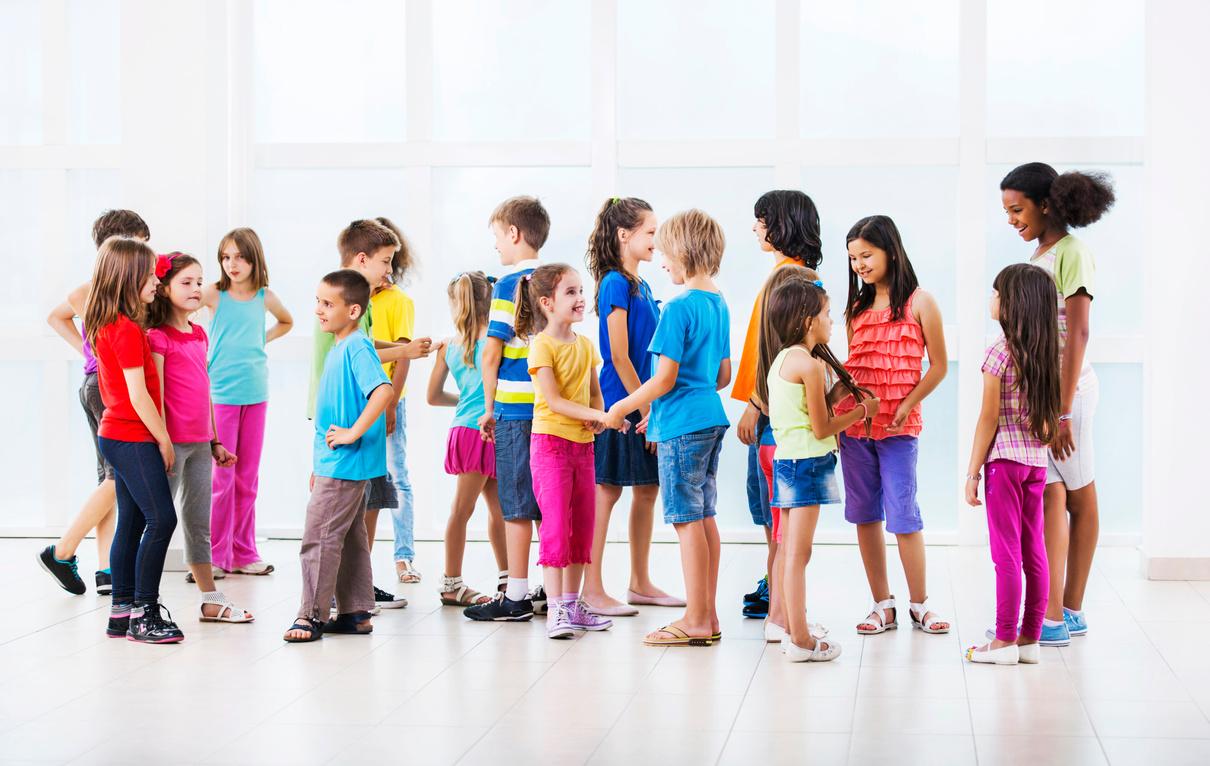
Deaf point of view would begin to shift the culture within schools Likewise, if ASL was taught as a core subject, to all students, whether hearing or Deaf, from Kindergarten through high school, many significant problems such as communication barriers, mindset barriers, parents and staff not signing would simply melt away, within a couple of generations.
As it is, audism and the “othering” it results in is a powerful influence in schools But the novelty of the word “audism” makes it hard to call people out on it.
In Echo, Alaqua says “The Kingpin has had his run Now it’s time for a Queen ” Likewise, white, hearing Hollywood has had its run; it’s time for true diversity. Audism has impacted enough generations of Deaf people; it’s time for educational equity.
Dr. Leala Holcomb also says “There need to be more policies and science that
focus on supporting both spoken language and signed language, which will, in turn, be incorporated into training programs for medical and educational professionals. This is where their attitudes and ideologies may shift.”
DHH Education Specialist
Kei-Che Randle raises a great question “How do we support Deaf communities in an effort to groom more Deaf educators, artists, and performers?” We must increase and accept education that encourages a Deaf-positive mindset.
The media can start by adding powerful, shocking factual information to jolt people out of their enjoyment, their complacency, and their false sense that everything is alright now; that our problems are fixed
The Deaf Renaissance is a stepping stone. Hearing people needed to see the beauty, the power, the talent, and the benefits of ASL and Deaf pride But
only when they and we also get awoken, alarmed, and angry enough to take action will real, structural change happen where it matters the most; first in our medical offices and schools, then in the hearts of parents of Deaf children And finally, in the children themselves, like Ryan, my student years ago.
Perhaps seeing more Deaf people on TV will offset the scarcity so many of our children experience in the mainstream.
So they don’t wonder if they’ll die at age 18
To learn more about Rachel and her book, The Butterfly Cage - please visit her at:
www.rachelzemach.com
Rachel Zemach is a Deaf author. Her book “The Butterfly Cage; Joy Heartache and Corruption. Teaching While Deaf in a California Public School,” was released last year It describes her career, personal identity shift, and the trajectories of individual students, as well as the stunning dysfunction in mainstream Deaf education. Her book is an attempt to trigger a national dialogue on the topic. Its' forward is written by Dr Paddy Ladd Zemach lives in North California.
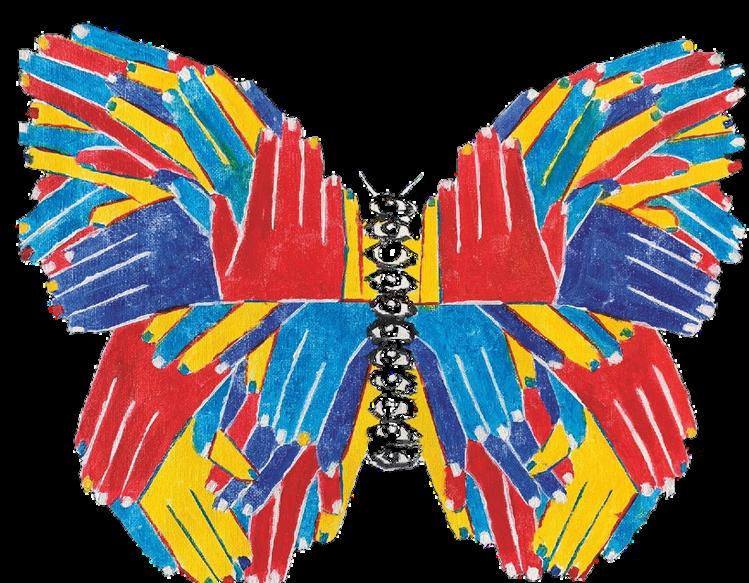
“The Butterfly Cage by Rachel Zemach is a remarkable, beautifully written, and important book For those of us involved in education and with any experience with the vibrant Deaf Community in America, this is absolutely a required reading. But Ms. Zemach takes us way beyond to the larger issue of the beauty and diversity of language and the fundamental right that we should all have to develop and access language. I am honored to recommend this book.”
- Larry Siegal, author, Special Education attorney, and Hastings law professor

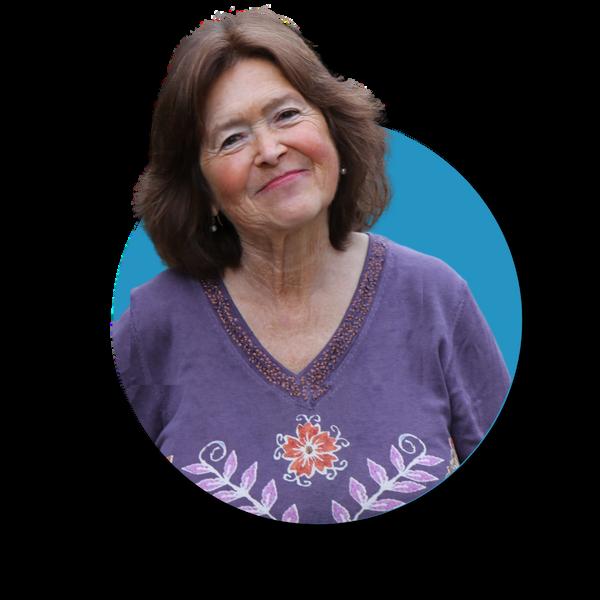
"The v can't be overstated...from a Deaf teacher working in a hearing school."
A tender and perspective-shifting book that offers a rare level of understanding about the subtle and and no-so-subtle layers of internalized oppression and deep feelings and dilemmas of Deaf people, written by former Deaf teacher Rachel Zemach.



Join us for enlightening discussions, enjoyable family activities, and sessions tailored for parents and professionals with D/HH youth in the following age categories:
Middle & High School with a special emphasis on navigating the transition after the school bus stops.

February 10th, 2017.
My then-husband and I packed up in the car before the sun came up and headed to the local hospital I was 39 weeks pregnant and elated to be almost done. This was my third child, and this pregnancy was much more difficult than my last two For the last 5-6 weeks, I felt weak and tired. I just couldn’t participate in the ups and downs of toddler town at home I checked my bag one more time and I had everything I needed, plus the onesies I had personalized with names: one with a male name and one with a female name. We tried a different method during this pregnancy We wanted to wait and find out at birth the sex of our baby I had previously had a girl and a boy, both still young, and I am part hoarder, admittedly, so I had everything I needed regardless
“It’s going to be a girl,” I said as we backed out of the driveway
“What?” My ex said, still trying to wake up and catch his bearings.
“I had a dream, Stephen. It’s going to be a girl, small, with a lot of hair.”
Little did I know that dream was what I now have come to call my promise, my assurance from the Universe that little Peighton Harper would be safe.
Fast forward to a busy surgery suite, and a 2-hour C-section I held my breath as I both felt and heard the amniotic fluid rush out of my body
“It is a girl She is small She has a lot of hair,” my highrisk obstetric doctor said.
Stephen looked at me stunned “You were right” –he whispered in disbelief
I was wheeled into the recovery area and handed a beautiful dark-haired beauty who just gazed at me as deeply and silently as I gazed at her She was so tiny She didn’t cry, just intently looked at me. I could hold her in one hand, but I wouldn’t dare it. I held her carefully, with both hands, trying to figure out how to nurse a baby whose mouth was so tiny
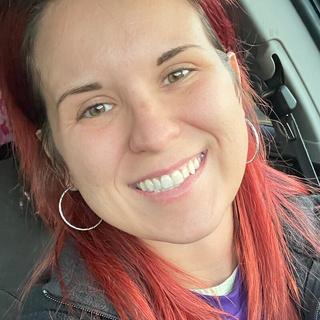
I started to look at her, inspect the fingers and the toes, and I noticed something that wasn’t right “Excuse me, ” I stopped the nurse as she was getting her supplies together to do her additional assessment of Peighton. “Is that petechiae that I am seeing?”
The nurse picked up her portable phone, and she said, “Yeah, it’s petechiae. No. Yes. Yes. Okay.” She hung up and told me not to worry, and she proceeded to check Peighton’s blood sugar 38 Petechiae, a skin rash of scattered red dots, told me that her liver wasn’t functioning correctly, and a low blood sugar meant Peighton might have some underlying illness or insufficiency Shantelle, our nurse, dropped the smallest little tube into her stomach through her mouth and gave her a small bolus of formula 68 Better, not perfect, but good enough to go to Mother Baby Unit to see the crowd waiting to see what the caboose would be
“Girl? Boy?” My dad looked down “Small, that’s for sure. ”
I held her in my hands, and again, she intently stared at me, silent. 5 pounds, 4 ounces, and somehow a full-term baby One by one, my family left and left us to change the first diaper, which I gave that honor to Stephen. As he finished doing his best to fit a newborn diaper on a preemie-sized baby after continuing to glance at me for any guidance on how to change a baby so small, a nurse came in and said she needed to take Peighton for a test, wasn’t specific, but I was starving, and I trusted the pink tagged ladies that worked on the Mother Baby Unit. I nodded and let her go.
About 45 minutes passed, and my dinner tray had just been placed near my bed My legs were still numb from the epidural, and I couldn’t get up yet, so I slid the table across the bed, and just then, someone knocked on the door Ah, so close. My nurse walked in to give a bedside shift report to the oncoming nurse, something we do routinely to both put an eye on our patients, introduce ourselves, and discuss what the plan of care is. I smiled
I smiled and waved, and this young nurse stopped mid-report and said, “You know your baby is going to NICU right?” My eyes widened, and I wasn’t hungry anymore
“What?” I was in shock and tears welled up in my eyes “What is wrong with her? What happened?” She had no answers, and I couldn’t process what was going on I started to get increasingly upset, and she excused herself and exited quickly. I swung my lifeless, tingling legs out of the bed. “What are you doing?!” I heard from the couch, Stephen, sitting up as I kept towards the side of the bed I stood up and wavered. “I am going to see what is going on. ” I was hellbent and determined I got myself to the end of the bed and sat in the chair Just then a doctor walked in that I didn’t recognize.
“Samantha, I am Dr Smalling I work in the NICU, the neonatal intensive care unit Your daughter, well, we have some concerns. Her brain is bleeding, due to her platelet count being very low, which caused the petechiae you saw Also, her spleen and liver are very large I have her in the unit, and we are looking at a platelet transfusion.” Again, in disbelief, I echoed, “A transfusion?” I snapped out of the trance I was in and went straight in with questions.
“How low?”
“19,000 ” Anything under 150,000 is considered low, so 19,000 was critically low
“How bad is the bleed?”
“Well, it is a Grade I, but with her platelets so low, I’m concerned it is going to start putting pressure on her brain tissue ”
The next morning proved more difficult “The transfusion didn’t work, Samantha.” Dr. Smalling sat next to me I sat there with Peighton all night in the NICU I couldn’t sleep knowing she was alone
He explained that the diagnosis he originally gave her could still be the reason for her sickness, but he would need to fly specialized platelets in from Texas and Alaska and transfuse her to see if the count rose.
“Do whatever you need to, just please help her ” I looked down.
“And Samantha…” he paused as he got me to look into his eyes, “her bleed is worse It is now a Grade II and that means that it is going to cause damage soon. ”
Three IVs Fluids Beeping Monitors Flashing Lights And there she was And she was calm Too calm for all the noise around her. I sang to her from the side of the warmer, and she wouldn’t look at me “Weird,” so I moved to where she was staring off and our eyes met. I kept within her eyesight and stayed devotedly.
The second transfusion didn’t work Neither did the third one But I wasn’t going
to leave her side, and fortunately, the nurses began to protect me from policy and rules. They let me stay in the corner with my baby around the clock in the NICU
It was time for lab work, so I knew it was morning, but I didn’t know what day it was anymore. “10,000?! So, it’s worse? And her bleed? Is that worse too?” I couldn’t grasp the nurse ’ s response when I asked how her labs looked.
“I’m not sure We didn’t reimage her today, but I am sure Dr Smalling will come talk to you soon ” My nurse took off to the other side of the unit and later came back with Dr. Smalling.
“So give me the plan Dr Smalling What’s next?”
“We are testing her for something called Congenital Cytomegalovirus, but the test is a sendoff, so it would take a few days to get the results.” He continued to explain to me what Congenital Cytomegalovirus or Congenital CMV was, that I possibly contracted the virus during my pregnancy, which explained my sickness, but that it doesn’t happen for every mother, most mothers are asymptomatic or without symptoms It travels through the bloodstream to the unborn baby and attacks them. Most times the virus can attack their vision, hearing, and most importantly, their brain But when he said hearing, it stopped me momentarily.

National CMV Foundation
1646 W Snow Ave, Suite 84 Tampa, FL 33606
National CMV Foundation PO BOX 18322 Tampa, FL 33679
www.nationalcmv.org
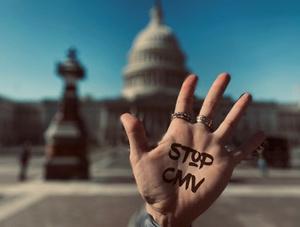


I thought about Peighton’s silent stare, her not looking when I sang to her, and her not being startled by the commotion in the NICU of all the noises I knew this had to be the answer as he continued to explain that the treatment is timesensitive and must be given before 21 days old to be effective. With my permission, he would give her an antiviral medication, valganciclovir, and retest her platelet count the next morning. I wholeheartedly agreed.
The next morning, her platelets skyrocketed to 100,000 Then the next morning, she was in the normal platelet range. And her bleed? It started to resolve The antivirals were working, but what did her
having Congenital CMV mean for her future? And is anything else going on?
Questions circled me, but because she was improving, I got to hold my baby again. Time stood still
We ended up spending a total of two weeks in the NICU. She received her antiviral therapy daily and her Congenital CMV test came back positive Confirmation Her vision ended up not being affected, as compared to some children born with CMV who suffer from retinitis and potential vision loss However, she failed her hearing screen, but remember those questions I had in my mind, and how I felt like she wasn’t reacting? I already knew. Peighton was deaf and her type of hearing loss was caused by the virus she had; it was sensorineural hearing loss.
Her journey continues today Peighton is now six years old and a bilateral cochlear implant user Her infection caused her to have progressive hearing loss until at three years of age, and in the year of COVID, she completely lost
her hearing She has seizures, absence seizures, due to leukoencephalopathy and white matter disease developed from the infection She utilizes an IEP through the school system as a child with “Multiple Disabilities”, and she has attended over 800 therapies to correct the muscle weakness that CMV caused her to have can walk, jump, and play just as roughly as her peers, but she wasn’t handed that potential, she worked for it.
I tell her story to everyone I meet and anyone who will listen because 1 in 200 children are born with Congenital CMV each year. A virus that fertility doctors look for if women are having miscarriages, but not a test done in a routine pregnant woman ’ s prenatal panel. A virus that can disguise itself as other disease processes, until it is too late to treat it to stop the harm, and that isn’t included on the RUSP panel for universal newborn screening. A virus that has assembled concerned parents and physicians across the

United States to form the National CMV Foundation –with a mission to prevent pregnancy loss, childhood death, and disability due to Congenital Cytomegalovirus A virus that had the potential to catastrophically destroy my family, but now is an opportunity to share Peighton’s story and hopefully, save a life If you have any questions orwould like to know more about Congenital CMV, reach out to the National CMV Foundation.

Enhance your ASL Learning Experience with ASDC

